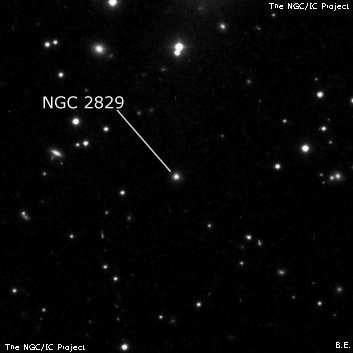
George Johnstone Stoney, Lord Rosse's assistant, discovered NGC 2829 on 13 Mar 1850, one of "15 knots in all". It was included on the sketch of 8 Jan 1851, which showed only a dozen nebulae, east of line connecting NGC 2832 and NGC 2826. The nearest galaxy to the NGC position is PGC 26356, an extremely faint, double galaxy (brighter western component) situated 2' NE of NGC 2826. RNGC and PGC identify this galaxy as NGC 2829 (as well as secondary sources based on the PGC). But, PGC 26356 is directly on a line with NGC 2832 and 2826, contradicting Stoney's sketch. Karl Reinmuth description (based on Heidelberg plates) was "identification doubtful, vF, vS, R, vgvlbM, triangle with 2 st nf and f, NGC 2826 sp 2.1'."
Harold Corwin suggests NGC 2829 might apply to LEDA 2036350, a brighter galaxy 4.6' due E of PGC 26356, though this galaxy is only a fair match with Stoney's sketch. The best fit to Stoney's sketch is a mag 14.5 star at 09 19 38.4 +33 39 12 (2000). So, the identification of NGC 2829 is uncertain - it may apply to PGC 2036350 (described here), but more likely is just a faint star 2.9' west of this galaxy. Seligman and Corwin (as of 2019) favor the single star as NGC 2829.
600/800mm - 24" (1/31/14): at 375x; LEDA 2036350 appeared very faint to faint (could hold steadily with averted), extremely small, round, 8" diameter. LEDA 3529523, a larger galaxy, lies 3.5' ENE and appeared faint, small, elongated 5:3 WSW-ENE, 20"x12.
The identification of this galaxy with NGC 2829 is very questionable and based on the discovery sketch, the best match is a mag 14.5 star 2.9' due west. PGC 26356, a double system 4.6' W, is often taken as NGC 2832, but it is fainter and a poor match with the discovery sketch. For completeness, my description of PGC 26356 follows.
24" (3/9/13): at 375x; extremely faint (B = 16.8), very small, round, 12" diameter. Nearly on a line between NGC 2826 1.9' SE and a mag 12.3 star 1.2' NE.
Notes by Steve Gottlieb